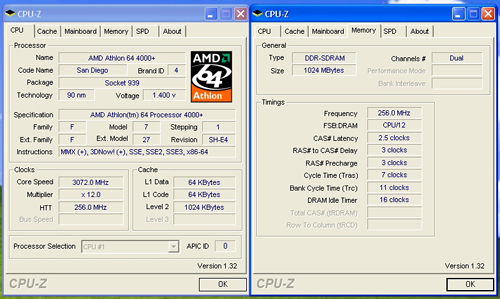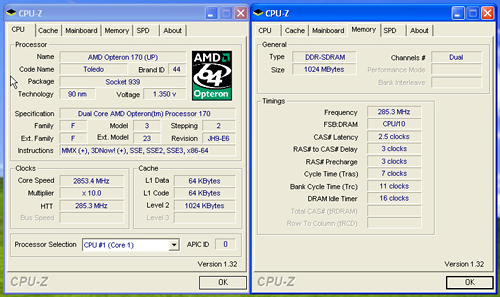Abit AT8: µGuru comes to the RD480
by Gary Key on March 10, 2006 12:05 AM EST- Posted in
- Motherboards
FSB Overclocking Results
Memory Stress Testing
Memory stress tests look at the ability of the Abit AT8 to operate at the officially supported memory frequencies of DDR-400, at the best performing memory timings that the OCZ PC4800 Platinum Edition will support.
The Abit AT8 was very stable with 2 DDR modules in Dual-Channel mode at the settings of 2-2-2-5 at 2.7V provided that we used the OCZ PC4800 memory and 1.1 BIOS. We will now install all four available memory slots, which will result in more strenuous requirements on the memory subsystem than testing 2 DDR modules on a motherboard.
The Abit AT8 was very stable with 4 DDR modules in Dual-Channel operation at the settings of 2-2-2-7, but required the command rate to be increased to 2T along with a voltage increase to 2.8. Once again, we had to utilize our OCZ PC4800 memory and BIOS 1.1 in order to achieve these settings. Although other memory types were fully compatible, they required the 1.1 BIOS and memory settings adjusted to SPD values in the BIOS for one reboot sequence before changing the memory settings manually.
| Front Side Bus Overclocking Testbed | |
| Processor: | AMD Athlon 64 4000+ ( San Diego) AMD Opteron 170 ( Toledo) |
| CPU Voltage: AMD Athlon 64 4000+ AMD Opteron 170 |
1.5250V (1.4000V default) 1.4500V (1.3500V default) |
| Memory Settings: | 2.5-3-3-7 1T - (12x) 2.5-3-3-7 1T - (10x) |
| Memory Voltage: | 2.9V +.30mV |
| NB 1.2V Setting: | 1.60V |
| HT Voltage: | 1.35V |
| LDT Multiplier: | 5x up to 250HTT, 4x up to 285HTT |
| Memory: | OCZ PC4800 Platinum Edition |
| Cooling: | Zalman CNPS9500 |
| Power Supply: | OCZ Power Stream 520 |
| Maximum CPU OverClock: (AMD Athlon 64 4000+) |
256HTT x 12 (3072MHz) +28% |
| Maximum HTT OverClock: (AMD Athlon 64 4000+) |
256HTT x 9 (2304MHz) +28% |
| Maximum CPU OverClock: (AMD Opteron 170) |
285HTT x 10 (2850MHz) +42% |
| Maximum HTT OverClock: (AMD Opteron 170) |
285HTT x 9 (2565MHz) +42% |



Memory Stress Testing
Memory stress tests look at the ability of the Abit AT8 to operate at the officially supported memory frequencies of DDR-400, at the best performing memory timings that the OCZ PC4800 Platinum Edition will support.
| Abit AT8 Stable DDR-400 Timings - 2 DIMMs (2/4 slots populated - 1 Dual-Channel Bank) |
|
| Clock Speed: | 200MHz |
| CAS Latency: | 2 |
| RAS to CAS Delay: | 2 |
| RAS Precharge: | 2 |
| RAS Cycle Time: | 5 |
| Command Rate: | 1T |
| Voltage: | 2.7V |
The Abit AT8 was very stable with 2 DDR modules in Dual-Channel mode at the settings of 2-2-2-5 at 2.7V provided that we used the OCZ PC4800 memory and 1.1 BIOS. We will now install all four available memory slots, which will result in more strenuous requirements on the memory subsystem than testing 2 DDR modules on a motherboard.
| Abit AT8 Stable DDR-400 Timings - 4 DIMMs (4/4 slots populated - 2 Dual-Channel Banks) |
|
| Clock Speed: | 200MHz (800FSB) |
| CAS Latency: | 2 |
| RAS to CAS Delay: | 2 |
| RAS Precharge: | 2 |
| RAS Cycle Time: | 7 |
| Command Rate: | 2T |
| Voltage: | 2.8V |
The Abit AT8 was very stable with 4 DDR modules in Dual-Channel operation at the settings of 2-2-2-7, but required the command rate to be increased to 2T along with a voltage increase to 2.8. Once again, we had to utilize our OCZ PC4800 memory and BIOS 1.1 in order to achieve these settings. Although other memory types were fully compatible, they required the 1.1 BIOS and memory settings adjusted to SPD values in the BIOS for one reboot sequence before changing the memory settings manually.










42 Comments
View All Comments
CrystalBay - Friday, March 10, 2006 - link
sorry, ;)Witchfire - Friday, March 10, 2006 - link
I have to disagree that the reviewers do not follow up on comments or complaints from users. Gary has been communicating with me regularly about my concerns with the AT8 I've been having, and has been very helpful. I'm no eleite member, and haven't even managed triple digit postings, yet he took the time & trouble to listen to my concerns, attempt to recreate them on his mobo, and lend assistance.Thanks, Gary, your help and professionalism have been greatly appreciated.
bthjf1 - Friday, March 10, 2006 - link
The problem with all these reviews is that they don't go back to check what's is going one with the board they just tested with normal users. A number of peoples (one being me) have been arguing (with their helpdesk) and waiting for 3 months now for Abit to provide a proper support for the intel Presller core on the AW8 motherboard series (i955) or proper support for different type of memory. All I can say Abit support is very very poor and I will strongly advice anybody thinking of purchasing a board from Abit to look elsewhere. Just poppin's into http://forum.abit-usa.com/showthread.php?t=102711">http://forum.abit-usa.com/showthread.php?t=102711 and have a read ...Gary Key - Friday, March 10, 2006 - link
I cannot comment on other review sites, but I can assure you that Wes and I do go back and look at the history of the motherboards tested and take comments from users very seriously. I know I spend at least 10 hours a week assisting users with their issues and at times being an arbitrator for the customer with the supplier. We both spend a similar amount of hours each week if not more working directly with the suppliers on issues and trying to ensure problems are solved or at least corrected in the next product design. While we are not always successful, I do believe you would be surprised at the number of issues that are solved quickly. I will bring up your AW8 issue with Abit this weekend. :)
bthjf1 - Saturday, March 11, 2006 - link
Thanks for any help you can provide. The comment was not direct to Anandtech but to a couple of other review sites which didn't really care (ie: not my problem). The concern with Abit is since the takeover from USI the support have not been great ~ total of communication. I've been reading Anandtech for many years (too long !) and my post was more to get some help with Abit . They will listen to Anandtech since you can reach millions but not necessary a single user ;-)Jon
Plasmoid - Friday, March 10, 2006 - link
I have to agree with you, Abit need to sort out their support.The benchmarks prove that this is a great motherboard, interestingly it outperforms all its rivals at stock just like the AN8, but the bios lets it down (interestingly just like the AN8)
If they can sort out these bios issues fast it should be a fantastic value motherboard. There were problems with the temperature reporting on the AN8 and incompatibility with XI-FI cards from creative that took much to long to address though. Im sad to say this kind of thing is what you can get with Abit. Hopefully it is a short term problem that they have had over the last 6 months.
All bad things said im really happy with my abit motherboard, and the OCGuru certainly is a godsend for overclockers. Havent seen such things as completly dynamic fan speed control in any other motherboard.
Patrese - Friday, March 10, 2006 - link
Am I the only one who finds this kind of positioning of the IDE connectors crappy? Most people who are buying PCs now are using SATA HDs, so the connectors should be exactly where they are, on the low-right of the board. But the IDEs are used for CD-RW/DVD-RWs drives mostly, and would be much better suited to the top right of the board IMO. I got a good-old AN7 and I just hate tbe IDE cables crossing my case from top to bottom just to reach the connnectors...Besides that, great review and promising mobo, once the BIOS is fixed. It's great to see Abit back!
n7 - Friday, March 10, 2006 - link
I think his comments were a tad harsh, but i am one of those users who read the Asus A8R-MVP review here, & got pretty excited.I actually starting spreading the praises on forums i visit of this great value mobo.
Then i got the mobo, & actually, i was quite happy with it.
For a few weeks, that is.
Then i started discovering all sorts of issues, the worst being the ethernet hanging/crashing, something which many others have also had issues..
I now hear there's a Marvell driver directly from their site that supposedly fixed the problem, but i've already bought an ethernet card, so i don't really care to try it, since both the driver from the CD & the driver from Windows update didn't work properly.
Another issue i've encountered is wildly fluctuating vcore. (1.31-1.41V, for example! - with overvoltage disabled)
Others have also reported this. I am using software to measure this, so it's possible that it is incorrectly reading it, but i'm guessing not.
Another problem is that even smaller overclocks aren't stable in games for me, whereas i had much higher OCs stable with my previous Neo2.
I cannot figure out why yet, but it seems to be either the fluctuating vcore, or it's been mentioned that the RAM isn't even stable even with a divider when using 1T.
It's one thing for OCs to vary between mobos, but going from 2.55 GHz to 2.2 GHz with the same hardware? No way.
I am going to test things this wknd with the RAM @ 2T, & see if that fixes the stability issues, but one shouldn't have to run RAM @ 2T on any good motherboard in the first place.
Anyway, what i'm trying to say is that while some many not have had trouble, a lot of people have, which is why there's negativity surround that A8R-MVP reviews.
As far as i am concerned, it seems like Asus used us who bought the A8R-MVP as beta testers so they could release the A8R32-MVP with the issues fixed...
Zoomer - Tuesday, March 21, 2006 - link
I get a similar problem with vCore on their A8N-E. Perhaps its due to Asus's choice of voltage regulator?Pete84 - Friday, March 10, 2006 - link
With conroe ~6 months away, I wonder how badly AMD's FX and high end sales will suffer. Who is going to spend out for a brand new system when it will be destroyed by Conroe?